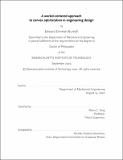A worker-centered approach to convex optimization in engineering design
Author(s)
Burnell, Edward(Edward E.)
Download1227278081-MIT.pdf (3.842Mb)
Other Contributors
Massachusetts Institute of Technology. Department of Mechanical Engineering.
Advisor
Maria C. Yang.
Terms of use
Metadata
Show full item recordAbstract
Design tools shape what engineers and their organizations consider desirable. In particular, "design models" that implement interactions amongst parameters are central to the work of early-stage concept development. Such models delimit the space of designs under consideration, and are built to intentionally expand, explore, or shrink that space. Engineers often develop close relationships with their models, seeing them as mirrors to their own cognition. Within an organization these models also work as rhetorical reinforcement, as maps labeled to argue for particular design decisions, and it is often within and around design models that workers' perspectives clash and coalesce. Design models are thus loci for understanding what might be built which encode decisions on why: they are mathematical artifacts, but so deeply intertwined with design process and practice that to see them purely mathematically misses much of what makes them interesting. This thesis establishes design models and their design spaces as inextricable from user experience. Specifically, although convex optimization is rarely analyzed for human factors, there is a great deal of overlap between convexity and design work. Such findings inform and are informed by GPkit, a modeling language for geometric programming developed by the author and used daily in both industry and academia. How organizations incorporated GPkit emerged from and inspired its syntax and algorithms, a two-way flow between mathematical structure and worker knowledge that formed contributions both to the formulation and interpretation of convex programs and to understandings of early-stage engineering design. For instance, dual solutions are generally more valuable than an "optimal design", and from this insight are drawn novel algorithms and design methods. There is great potential for software that collaborates with workers, for no-one knows as well as they how technology structures each day's work. This thesis demonstrates that conducting research with this in mind, as a participant in a worker-centered community of inquiry, can improve engineering design. Technology shapes what is considered desirable, and any success of this research has lain in taking that as both an opportunity and a responsibility.
Description
Thesis: Ph. D., Massachusetts Institute of Technology, Department of Mechanical Engineering, 2020 Cataloged from student-submitted PDF of thesis. Includes bibliographical references (pages 105-112).
Date issued
2020Department
Massachusetts Institute of Technology. Department of Mechanical EngineeringPublisher
Massachusetts Institute of Technology
Keywords
Mechanical Engineering.